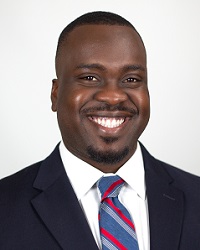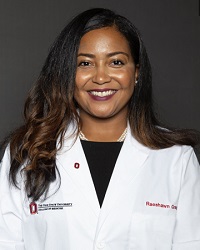Editor’s Note: The opinions expressed in this article are those of the author and do not necessarily reflect the opinions, positions, or the polices of the AAMC or its members.

Jovan Pierre-Charles
Undergraduate: Morehouse College
Major: Biology
Postbacc Program: The Ohio State University College of Medicine Medical Careers Pathway Post Baccalaureate Program (MEDPATH)
Program Focus: Academic Record Enhancement; Underrepresented minority students
Medical School: The Ohio State University College of Medicine
Anticipated Graduation Year: 2023
Bio: Jovan Pierre-Charles is Haitian-American from Miami, Florida, who is a current fourth-year medical student at The Ohio State University College of Medicine. Growing up, Jovan’s fascination with anatomy and the human body sparked his initial interest in medicine and led him to study biology at Morehouse College. He aspires to be a diagnostic radiologist with an interest in oncologic imaging and reducing health disparities. In his free time he enjoys boxing, listening to podcasts, and photography.

Raeshawn Gray, MPH
Undergraduate: The Ohio State University
Major: Neurosciecne
Postbacc Program: The Ohio State University College of Medicine Medical Careers Pathway Post Baccalaureate Program (MEDPATH)
Medical School: The Ohio State University College of Medicine
Anticipated Graduation Year: 2025
Bio: Raeshawn is a first-generation college student passionate about addressing health disparities and advancing women’s health in marginalized and underserved communities. She is a patient advocate and community leader who has also completed research on disparity in birth outcomes among Black women. As a Specialty Clinics Coordinator on the Columbus Free Clinic Steering committee, she manages operations for several specialty clinics and is dedicated to removing barriers to accessing healthcare. Raeshawn holds a BS in Neuroscience from The Ohio State University and a MPH in Health Policy and Administration from the University of Illinois at Chicago.
Why did you decide to do a postbaccalaureate program?
Jovan: I was attracted to postbaccalaureate programs because of their explicit purpose to help prepare applicants to be competitive and competent students in medical school. A postbaccalaureate program allows students designated time and space to develop critical thinking skills, mold study skills, and work on both personal and interpersonal skills. They allow one to stay particularly focused on the part of their medical school application that needs development. In my case, I needed to work on knowledge gaps that would ultimately help make my MCAT® score more competitive. My program afforded me that opportunity. Other programs incorporate working on course work, research, clinical exposure, or supporting a career change.
Raeshawn: As a nontraditional, first-generation student, I was employed throughout my undergraduate program. Even after I completed an MPH program, I felt I had room for improvement in some premed requirements and sought to strengthen my performance before applying to medical school. A postbaccalaureate program offered academic enhancement and a pathway to medical school.
How did you find out about and choose which programs to apply to?
Jovan: After completing undergraduate studies, students are either ready to directly apply to medical school or need alternative experiences or additional education to augment their application journey. In deciding I needed the latter, the first step I took was to connect with my undergraduate pre-health advisor to find out about postbaccalaureate programs. Next, I used the AAMC free postbacc database to compare programs, and then I used social media to connect with current medical students about their respective experiences in various programs. I ultimately chose my program based on their admission requirements, expected course work and program outcomes. I was also drawn to its mission to diversify the physician workforce by supporting students who are underrepresented in medicine.
Raeshawn: I learned of the MEDPATH program from a seminar I attended and emailed the program directors for additional information and admission requirements. They were all responsive, supportive, and welcoming. I searched the internet for postbaccalaureate programs and sought one with a linkage agreement to medical school matriculation. I applied to programs that had a strong investment with the students and individualized academic plans.
How did you decide which program best met your goals?
Jovan: In my search, I looked for programs that set high academic expectations, valued diversity, and prioritized work life balance. I also targeted programs that offered conditional acceptances (sometimes called “linkage agreements”) to medical school after completion of the postbaccalaureate program. In addition, I also focused on programs that offered scholarships and grants, had smaller class sizes, and had a robust presence on the web and social media. Through social media I connected with medical students who had gone through the program to get a better understanding of the culture and work life balance of their program.
Raeshawn: I decided on my postbacc program for three main reasons: academic enhancement, conditional acceptance to a quality medical school, and student wellness. Having attended Ohio State University as an undergraduate, I had observed the university culture firsthand. I knew of the program’s success by attending seminars and speaking with program alumni. Past students were very pleased with their experience and had gone on to achieve great success in medical school. The program facilitated a sense of community and camaraderie among the cohort.
I sought a program with rigorous academic requirements to best prepare myself for medical school. As long as GPA and MCAT requirements were met, my program provided acceptance to medical school. The program provided an MCAT prep course and access to tutoring for difficult topics. The MEDPATH program met all of my requirements and offered the opportunity to begin medical school with a stronger foundation.
How long did it take? What classes did you take?
Jovan: My one-year program started in the fall and ended the following summer. (Programs generally vary between one and two years). In the fall, Physiology I was required, as well as other classes from the catalog of Ohio State premed classes. I also took immunology, medical terminology, and pathophysiology. In the spring, courses included Physiology II, histology, and a MCAT prep course. The final summer rotation consisted of taking an anatomy course and preparing for medical school matriculation.
Raeshawn: The program lasted one year (programs generally range between one to two years). The MEDPATH program provided me with an individualized academic plan to help me ensure I met my educational goals. Some courses were required for all students while others specifically targeted an individual’s areas for improvement based on previous performance. In the fall I took Biochemistry, Advanced Human Physiology, the Science of Human Nutrition, and First Aid and CPR.
In the spring, I took Advanced Human Physiology 2, Human Histology, and a Keys to Online Success course to learn skills for the shift to online instruction during COVID. I also completed an MCAT prep course as part of the program. In the spring, after I completed all of the courses, I took the MCAT exam, then, in the summer I took Anatomy, Biochemistry, and Immunology. The following fall, I matriculated directly into medical school.
Did you get a degree or any certificates at the end?
Jovan: No degree was awarded upon completion of the postbacc program. However, students who met the linkage agreement requirements were awarded with admission into The Ohio State University College of Medicine. (Some postbacc programs offer a certificate or even a master's degree. You can search by this criteria in the AAMC Postbacc Database.)
Raeshawn: No degree or certificate was awarded for completion of the program. However, we did receive an acceptance letter to The Ohio State College of Medicine, which was my ultimate goal after all.
Did you have any shadowing or lab opportunities?
Jovan: My program allowed for shadowing opportunities due to the relationships students were able to make with matched resident mentors. During my postbacc year, I shadowed urology both in the operating room and outpatient clinic.
Raeshawn: While there are numerous opportunities for lab and shadowing opportunities at my program’s parent institution, it was not a program requirement; the main goal of the MEDPATH program is academic enrichment and study skills.
Do you have any advice for applicants looking into doing a similar program?
Jovan: My advice is to first evaluate yourself and understand what you need to work on in order to be ready to apply to medical school. Then, find a program that matches those goals. The hallmark of a good postbacc program is one that provides you with the skills to succeed in medicine and a program with a track record of producing medical students. Consider your ability to invest enough time in reaching your goals, the costs of programs, and your social network both inside and outside the classroom. Remain steadfast in your goal of pursuing medicine: constantly remind yourself why you have decided to take on sacrifice, hard work, and the calling to serve.
Raeshawn: I highly recommend pursuit of similar programs, namely those that have linkage agreements or offer conditional acceptance. (You can search for such programs using the free AAMC Postbacc Database.) For me, there was a sense of accomplishment and relief with knowing that I would not have to restart the application process. My postbacc program was invested in each student’s success and offered me individualized academic plans to strengthen my knowledge base. It also offered novice courses prior to entering medical school. I suggest those interested in a postbacc program should look to apply to programs that demonstrate their investment in their students and provide resources such as tutoring or study skills training. Try to speak with past students to learn how the program handles the student environment and their approach to wellness. Consider the culture of the program and if you’re able, try to choose a program that fosters connections within the cohort and with an affiliated medical school.